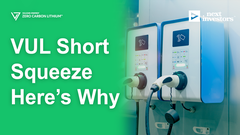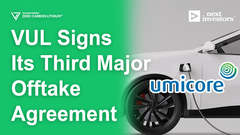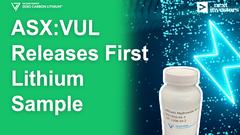A New Number One – Vulcan Energy ASX Now Hold the Largest Lithium Resource in Europe
Guess which part of the world is set to dwarf China’s growth for demand of lithium hydroxide?
Europe.
Europe is home to Volkswagen, Mercedes, BMW, and a host of other global car manufacturers which are rolling out electric vehicle (EV) models to meet consumer demand.
Demand for EVs in Europe — and the lithium-ion batteries that power them — is set to see massive growth over the coming decade, not unlike that seen in China in 2017-18. In the last decade China experienced the world’s highest growth in lithium-ion battery production for EVs. Over the coming decade, the same is forecast to happen in Europe — on a much larger scale.
However, the European industry faces a major hurdle: it has zero local supply of battery quality lithium hydroxide.
A second issue facing EV and battery makers is that their raw material supply chains have a hidden carbon footprint problem. It turns out that extracting lithium from the ground, processing it, then shipping it in diesel powered ships is very energy intensive. It means electric vehicles have a much larger carbon footprint than producers would hope.
Vulcan Energy Resources (ASX:VUL | FRA:6KO) is looking to change this, delivering much needed lithium supply to Europe, all while generating zero net carbon emissions in the process.
Vulcan, located at the heart of the European auto and lithium-ion battery industry, has seen the opportunity at hand and is fast tracking to first lithium production at its Vulcan Zero Carbon Lithium Project in Germany’s Upper Rhine Valley basin.
VUL is pioneering the world’s first and only “Zero-Carbon LithiumTM” process – its extraction of lithium from brines via its production wells will co-generate geothermal energy. This unique process will satisfy the EU’s requirement for zero carbon EV raw materials supply chain.
This is Europe’s most rapidly advancing lithium project, which was yesterday confirmed as also being Europe’s largest lithium resource at 13.2Mt contained Lithium Carbonate Equivalent (LCE).
The company has shot to the top of the pack as the largest JORC lithium resource in Europe, considerably larger than European Metals’ Cinovec at 7.17 Mt LCE, Rio Tinto’s Jadar at 6.24 Mt LCE, Infinity Lithium’s San Jose at 1.68 Mt LCE, and Savannah Resources’ Barroso at 0.71 Mt LCE — all of which are hard rock projects which inherently have a large carbon footprint in their extraction and processing.
Vulcan’s JORC Mineral Resource Estimate of 13.2Mt contained LCE, at an average lithium brine grade of 181 mg/l Li, elevates the Vulcan to a globally significant lithium developer.
That grade is exceptionally high for geothermal brines and is in same order of magnitude as South American brines. Importantly, these geothermal brines have the heat and power, so can operate profitably even at lower grades. Plus there is no need to build large evaporation ponds, as is the case for South American brines, making lower lithium grades cost prohibitive to them.
That is a significant step forward for this $6.8 million capped junior, suggesting plenty of upside for the company and its investors — it is valued by the market at less than one tenth of that of projects with smaller resources.
Vulcan plans to deliver carbon emission free product via a low-impact, Zero Carbon LithiumTM process powered by and sourced from geothermal wells requiring no environmentally damaging hard-rock mining, and no evaporation ponds.
While it’s still early days in the company’s development, production is expected to arrive quickly with first lithium targeted for 2023, via an agreement with a major German utility to access producing wells.
Vulcan Energy Resources is trading at just 16 cents per share, for a $6.8 million market capitalisation, and with $3.9 million in the bank (at 30 Sept), the company has a tiny enterprise value and significant potential for growth — especially so when considering that it holds Europe’s largest lithium resource, which is of a high grade for a geothermal brine-type deposit with readily available heat and energy for processing, and in a strategic location to deliver Europe’s electric vehicle market with the world’s first Zero Carbon lithium.

Market Capitalisation: $6.81 million
Share Price: $0.16
Cash in bank: A$3.9 million (at September 30)
Here’s why I like Vulcan Energy Resources:
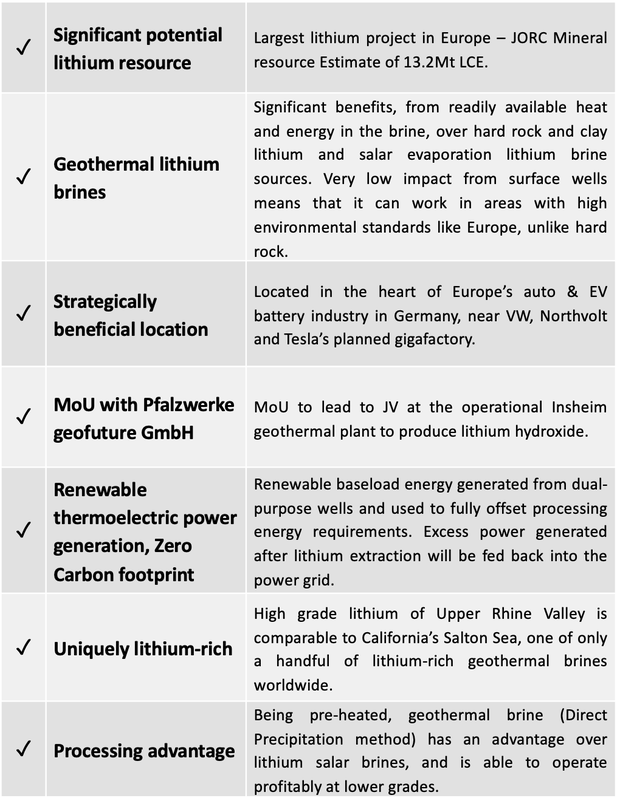
Vulcan Energy Resources Ltd. (ASX:VUL | FRA:6KO) is aiming to be the world’s first Zero Carbon LithiumTM producer to supply the burgeoning European EV and Li-ion battery markets.
The Vulcan Lithium Project is strategically located to provide the only zero carbon lithium product at the heart of the European auto and lithium-ion battery manufacturing industry. The company has a dominant license landholding in lithium-rich brine field in the Upper Rhine Valley of southwest Germany that’s comprised of five separate and non-contiguous Exploration Licences that include: Mannheim, Ludwig, Taro, Rheinaue and Ortenau, covering 788.19km2 (78,819ha) in total.
As I discussed in my last report on Vulcan, “Can Vulcan’s Zero Carbon LithiumTM Deliver Emission-Free Cars?”, Tesla’s Elon Musk is building a European gigafactory just outside of Berlin, while the country is home to a number of large automakers — including Volkswagen, BMW and Mercedes — who are seeking to supply Europe’s hungry electric vehicle market.
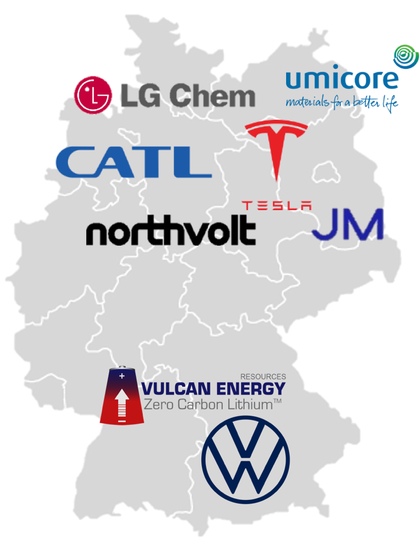
Not only is Vulcan strategically well located, this landholding is located in the world’s most well-explored graben meaning there are large quantities of existing 2D and 3D seismic data to shortcut development timeline.
Europe’s largest JORC-compliant Lithium Resource
Vulcan this week completed the maiden JORC (2012) Mineral Resource Estimate for its Ortenau licence within the Vulcan Zero Carbon LithiumTM Project, in the Upper Rhine Valley of South-West Germany.
Vulcan is now the largest JORC-compliant Lithium Resource in Europe by a considerable margin as well as being a globally significant lithium brine resource.
The total Inferred Mineral Resource for the brine has been calculated at 13.2 Mt of contained Lithium Carbonate Equivalent (LCE), at an average lithium brine grade of 181 mg/l Li.
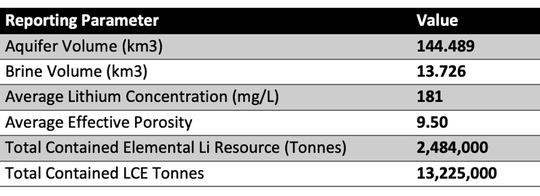
Note that this Maiden Mineral Resource Estimate was calculated on just one of the five licence areas within the Vulcan Project, where the majority of exploration licence areas remain as future “upside”.
Recent German Government policy emphasises conservation and promotes the development of renewable sources. Consequently, emphasis on stratigraphically deep geothermal wells in the Upper Rhine Graben has created access points to acquire deep, geothermally heated, lithium-enriched brine associated with the Buntsandstein Formation sandstone aquifer which forms an aquifer that underlies all five Vulcan Property Exploration Licences.

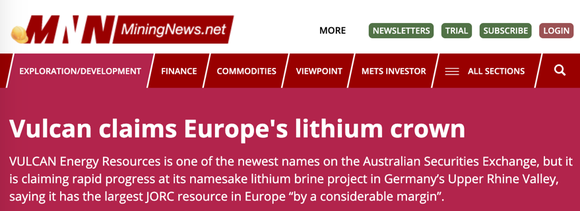
Vulcan conducted a data compilation and brine sampling program to verify historical geochemical analysis of the Buntsandstein Formation brine, which yielded an average lithium concentration of 158 mg/l Li.
Just days before news of the maiden JORC resources at the project, on 2 December, Vulcan reported lithium grades from its regional geothermal well brine sampling and analysis campaign.
The results were generally above expectations, ranging from 104 mg/l lithium to a maximum recorded value of 215 mg/l lithium (average of 181 mg/L lithium).
This is a globally significant grade, given that typical geothermal brine fields have lithium values in the order of 1-10 mg/L Li. The chart below highlights the comparatively high grade of Vulcan:
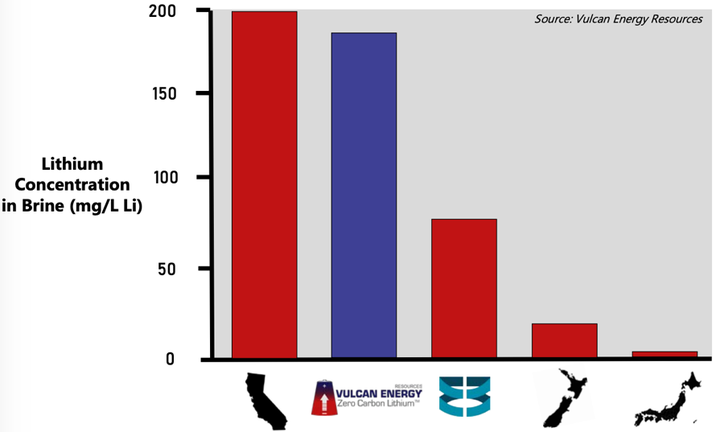
The highest average lithium grade was recorded from the Insheim plant where Vulcan has an MoU (memorandum of understanding) with the owner Pfalzwerke geofuture to earn in to 80% of the lithium rights, which I will detail shortly.
Also of note was the fact that brine collected from both hot and cold circuit sites of the Landau and Insheim geothermal plants returned similar lithium values, suggesting that almost no lithium is lost during the geothermal processing.
These results were discussed in this Finfeed article:
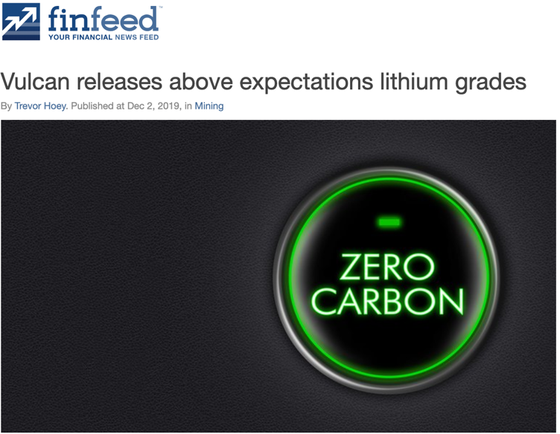
European lithium Resources
While Vulcan’s lithium grades are globally significant, the Inferred Mineral Resource Estimate of 13.2 Mt of contained LCE, compares very favourably to other JORC-compliant lithium resources in Europe.
These include:
- European Metals’ Cinovec at 7.17 Mt LCE,
- Rio Tinto’s Jadar at 6.24 Mt LCE,
- Infinity Lithium’s San Jose at 1.68 Mt LCE, and
- Savannah Resources’ Barroso at 0.71 Mt LCE.
Yet each of these are carbon intensive and environmentally damaging hard-rock projects.
Europe is the next “China 2017” for Lithium
The EU currently produces no battery-quality lithium hydroxide, and there is certainly no Zero Carbon product available. Yet, there is already a severe battery-quality lithium supply shortfall in Europe with slated battery and EV manufacturing.
The current battery material is sourced from hard rock or salar-type brine sources, which is then processed and transported to battery manufacturers and automakers in Europe, generating significantly more CO2 emissions than the manufacture of vehicles with traditional internal combustion engines.
Yet demand for lithium in Europe is on the rise. This is not unlike China in the 2010s, which experienced the world’s highest growth in lithium-ion battery production for electric vehicles. It caused a lithium supply shortage in China and a 300% lithium price spike.
In the 2020s, the same is forecast to happen in Europe, albeit on a much larger scale. We are now entering a period where Europe is forecast to dwarf China’s growth in demand for lithium hydroxide as part of the transition to electric vehicles.
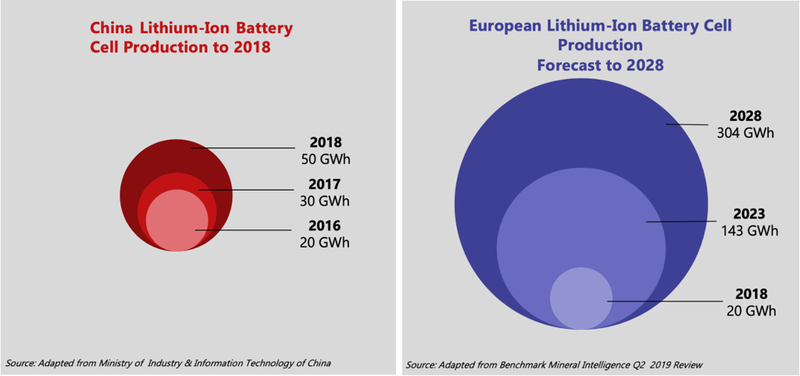
The Vulcan Project has potential to be a primary source for the burgeoning European battery industry’s lithium hydroxide needs, via a low-impact, Zero Carbon LithiumTM process powered by and sourced from geothermal wells.
Zero Carbon Lithium
Europe currently produces no battery grade lithium, plus, there are currently only high carbon emission sources of lithium hydroxide available to cathode and battery manufacturers.
In response, Vulcan is aiming to establish the Vulcan Zero Carbon LithiumTM Project, the world’s first Zero Carbon LithiumTM project.
Models indicate that Vulcan’s lithium hydroxide product will have a net negative total carbon dioxide to Lithium hydroxide monohydrate (tCO2 / tLiOH•H2O) impact, decarbonizing both the European power system and lithium supply chain.
Compare this to both hard rock / spodumene sourced lithium that’s converted by fossil fuel-fired processes and to lithium transported from South American brines, each of which emit significant quantities of CO2 in bringing their lithium product to market in Europe.
Here’s a comparison of the carbon intensity of Vulcan’s geothermal brine to lithium sourced from hard rock spodumene and salar-type brines:
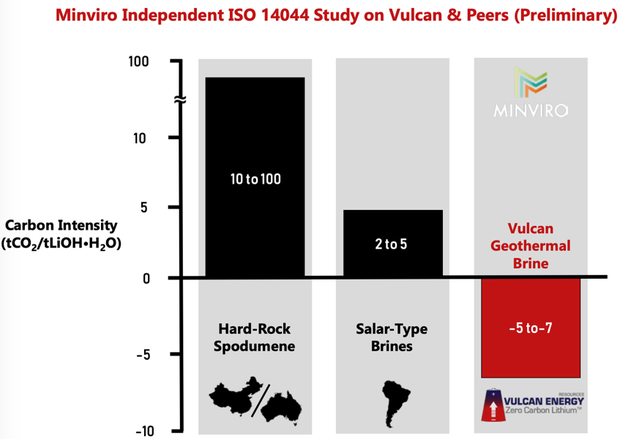
Vulcan intends to achieve this by producing battery-quality lithium hydroxide from hot, sub-surface geothermal brines pumped from wells, with a renewable energy by-product fulfilling all processing energy needs.
Vulcan has developed a unique flowsheet, making use of binary cycle geothermal electricity and heat to create a Zero Carbon LithiumTM product:
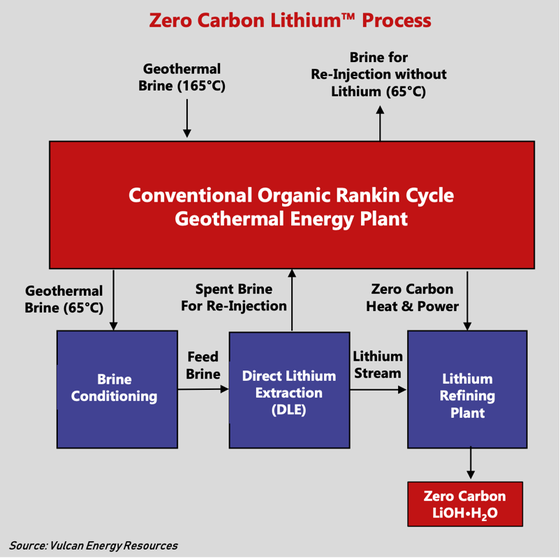
This flowsheet integrates geothermal energy production, the de-risked Direct Lithium Extraction (DLE) process to produce LiOH•H2O from the brine, and zero carbon electricity generated and used to produce premium, Zero Carbon LithiumTM with no gas input. Plus, the spent brine re-injected into reservoir with no evaporation losses.
This will create high purity, high concentration solution that is easily converted on site into battery quality LiOH•H2O. Any excess power will be sold at a Feed-in-Tariff of €0.25/kWh, displacing coal and decarbonizing the German electric grid.
There’s no need for high energy mining, crushing, grinding and conversion processes used in hard-rock lithium deposits. Plus, the processing time is counted in hours instead of months and isn’t dependent on weather like South American brines.
Collaboration with Pfalzwerke geofuture – a transformational step
It’s been a busy month with Vulcan having also signed a MoU with Pfalzwerke geofuture GmbH for a JV at the operational Insheim geothermal plant to produce lithium hydroxide.
This is a transformational agreement for Vulcan, providing access to lithium-rich, producing brine operations neighbouring Vulcan’s existing project area.
Pfalzwerke geofuture GmbH is part of the well-respected German utility, Pfalzwerke Group — an endorsement of Vulcan’s progress in terms of moving to a Zero Carbon Lithium producer.
The Insheim geothermal plant is currently pumping lithium-rich brine to the surface for energy generation, but not processing and extracting the lithium, before the brine is reinjected into the reservoir. The plant has been operating successfully for seven years, providing Vulcan with predictability of supply.
The MoU constitutes an initial collaboration period, during which Pfalzwerke geofuture will supply live brine and well data from its operational geothermal power plant for Vulcan to use in its prefeasibility study.
A Joint Venture will then be established, under which Vulcan will earn up to 80% of the lithium rights at Insheim by completing a definitive feasibility study (DFS), for lithium extraction.
As part of its DFS, Vulcan will construct and implement a demonstration plant at Insheim. Following completion of the DFS, Pfalzwerke geofuture can then choose to co-contribute to the construction of a commercial-scale lithium plant on site, or dilute interest to a royalty on lithium production.
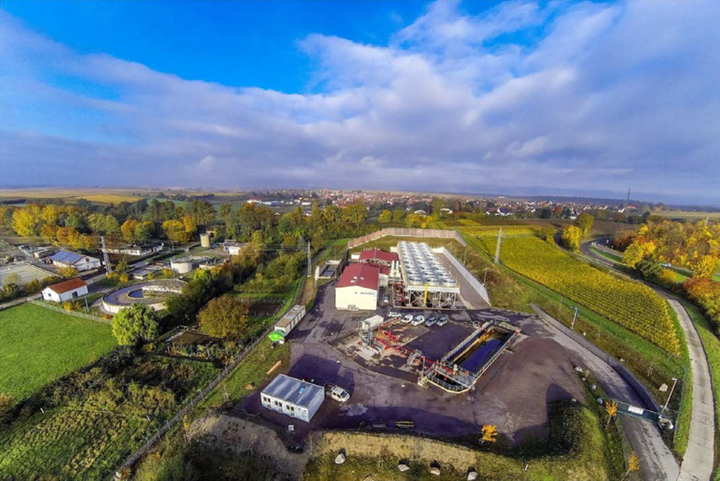
This gives Vulcan access to a lithium-rich, producing geothermal brine operation, so that feasibility studies and potentially first lithium production can be achieved in a much shorter timescale, prior to the company drilling its own geothermal wells.
This announcement was widely covered by the media:
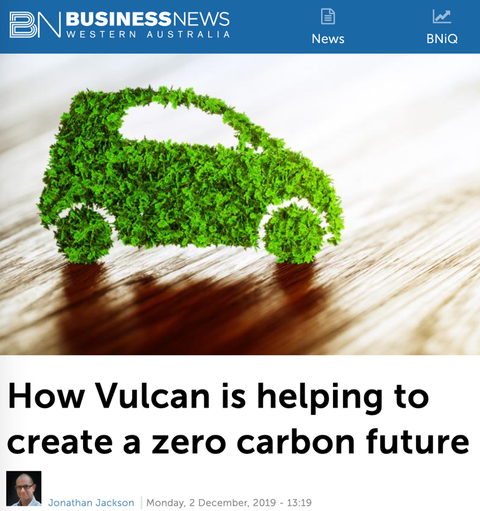
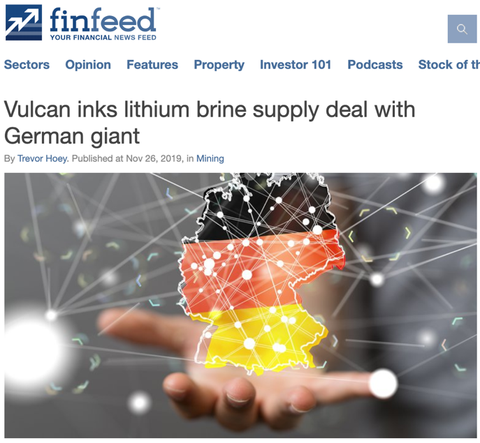
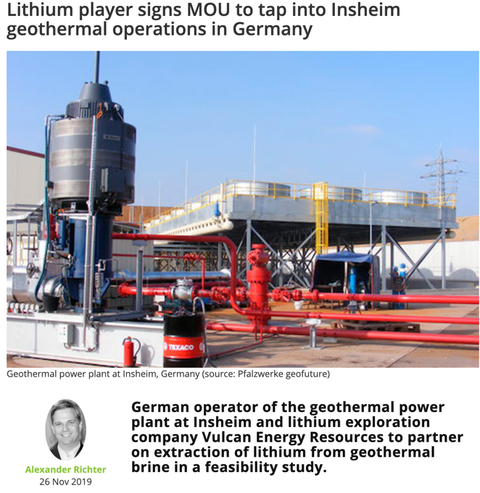
Vulcan lists on Frankfurt Stock Exchange
Vulcan yesterday announced the dual listing of the company’s shares on the Frankfurt Stock Exchange, under the code “6KO”.
The Frankfurt Stock Exchange is the world’s third largest exchange-trading market, behind the New York Stock Exchange and NASDAQ, while over half of all trades on that exchange are made by investors in countries outside of Germany.
This secondary listing widens Vulcan’s investor reach and increases the company’s exposure to German and European markets, where the Vulcan Zero Carbon Lithium Project is located.
What’s Next for Vulcan?
With the company trading at just 16 cents per share for a $6.8 million market capitalisation, there’s plenty of upside potential that may be recognised sooner rather than later.
A comparison with other lithium companies highlights the extent to which Vulcan is flying under the radar.
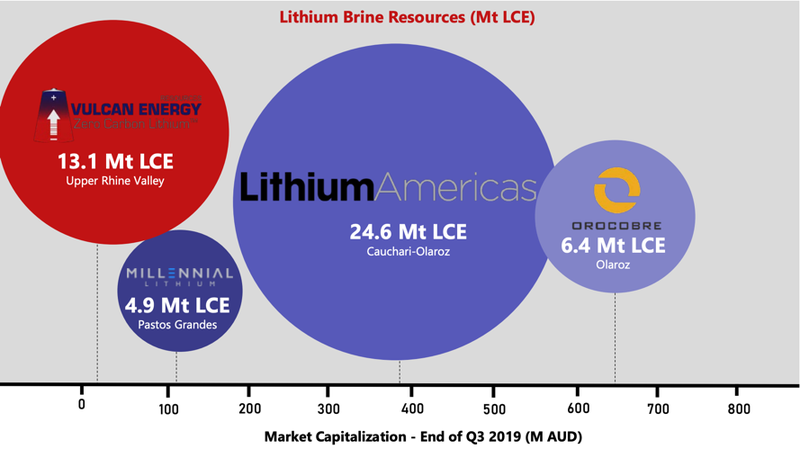
The project is clearly of a world-class size, yet it is valued by the market at less than one tenth of that of projects with small resources.
Plus, how we can forget the project’s location, right in the heart of the Europe EV and battery boom in trucking distance to multiple gigafactories and battery and EV makers.
In addition, the company now has confirmation of having Europe’s largest lithium JORC Mineral Resource Estimate, a MoU with the Germany utility, Pfalzwerke for access to its geothermal facility at Insheim, and is on a fast-track to production with first lithium anticipated in 2023.
Fast-track development of the project is under way, with the Resource Estimate being incorporated into a Scoping Study that’s due in the first quarter of 2020 and the company targeting production of lithium hydroxide by 2023.
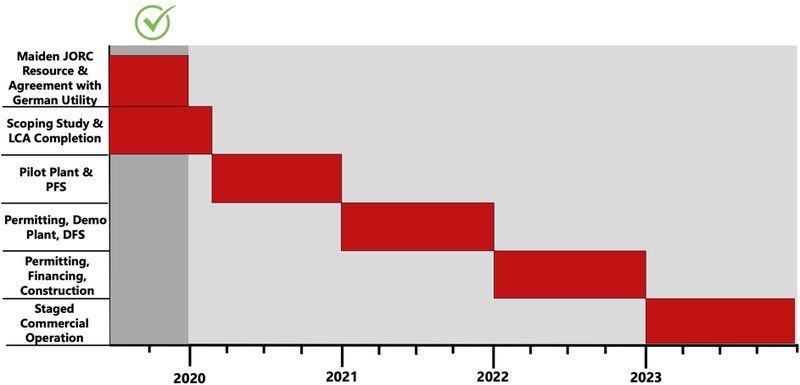
The maiden Resource is now confirmed, while the company’s MoU with Pfalzwerke geofuture, gives Vulcan access to a lithium-rich, producing geothermal brine operation, so that feasibility studies and potentially first lithium production can be achieved in a much shorter time.
General Information Only
S3 Consortium Pty Ltd (S3, ‘we’, ‘us’, ‘our’) (CAR No. 433913) is a corporate authorised representative of LeMessurier Securities Pty Ltd (AFSL No. 296877). The information contained in this article is general information and is for informational purposes only. Any advice is general advice only. Any advice contained in this article does not constitute personal advice and S3 has not taken into consideration your personal objectives, financial situation or needs. Please seek your own independent professional advice before making any financial investment decision. Those persons acting upon information contained in this article do so entirely at their own risk.
Conflicts of Interest Notice
S3 and its associated entities may hold investments in companies featured in its articles, including through being paid in the securities of the companies we provide commentary on. We disclose the securities held in relation to a particular company that we provide commentary on. Refer to our Disclosure Policy for information on our self-imposed trading blackouts, hold conditions and de-risking (sell conditions) which seek to mitigate against any potential conflicts of interest.
Publication Notice and Disclaimer
The information contained in this article is current as at the publication date. At the time of publishing, the information contained in this article is based on sources which are available in the public domain that we consider to be reliable, and our own analysis of those sources. The views of the author may not reflect the views of the AFSL holder. Any decision by you to purchase securities in the companies featured in this article should be done so after you have sought your own independent professional advice regarding this information and made your own inquiries as to the validity of any information in this article.
Any forward-looking statements contained in this article are not guarantees or predictions of future performance, and involve known and unknown risks, uncertainties and other factors, many of which are beyond our control, and which may cause actual results or performance of companies featured to differ materially from those expressed in the statements contained in this article. S3 cannot and does not give any assurance that the results or performance expressed or implied by any forward-looking statements contained in this article will actually occur and readers are cautioned not to put undue reliance on forward-looking statements.
This article may include references to our past investing performance. Past performance is not a reliable indicator of our future investing performance.



